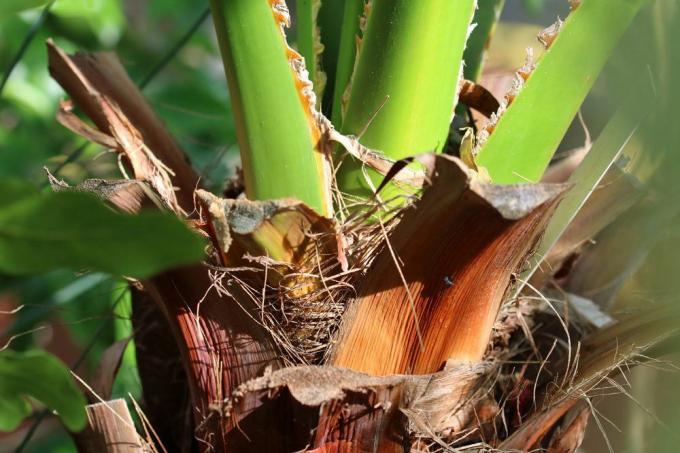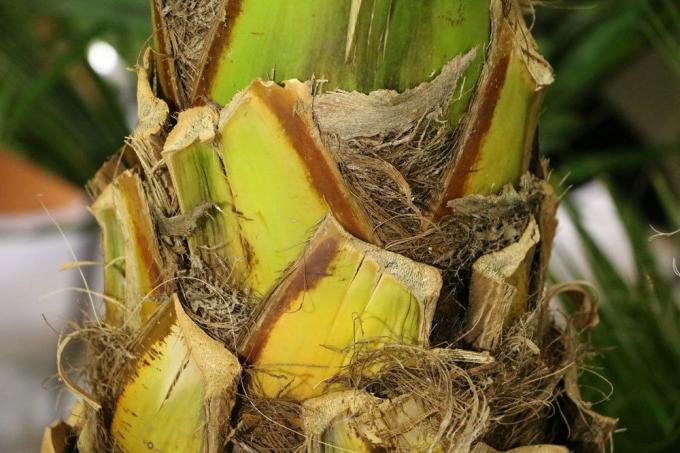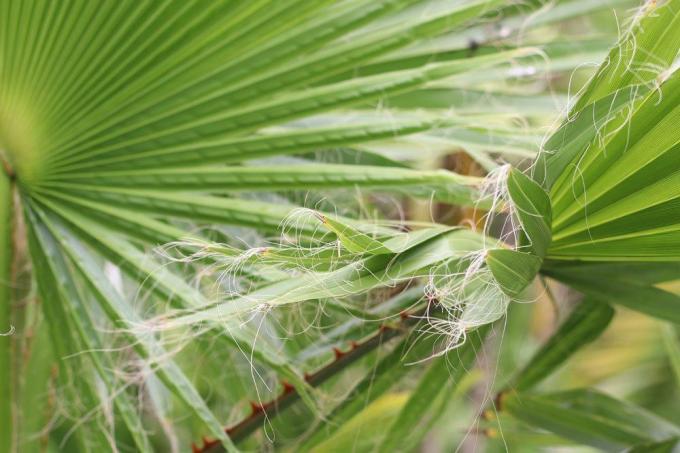
table of contents
- Characteristics
- care
- Location
- Planting time
- to water
- Fertilize
- Cut
- Multiplication
- Diseases
- Pests
Profile and care information open +conclude -
- Flower color
- yellow white
- Location
- Partial shade, sunny, full sun
- Heyday
- May June July
- Growth habit
- upright, spreading, bushy, perennial, clump-forming, overhanging
- height
- 3 meters to 30 meters high
- Soil type
- sandy, loamy, gritty
- Soil moisture
- moderately moist, fresh
- PH value
- neutral, slightly acidic
- Limescale tolerance
- Calcium intolerant
- humus
- low in humus
- Poisonous
- no
- Plant families
- Palm family, Arecaceae
- Plant species
- Potted plants, Balcony plants, Houseplants, Ornamental plants
- Garden style
- Pot garden, winter garden, residential garden, ornamental garden
Washingtonia robusta is a species of palm that brings the flair of California and Mexican sandy beaches home. In terms of care, it is considered to be easy to handle, but it still has some basic requirements in order to be able to grow vigorously and stay healthy for a long time. At Plantopedia you can find out how you can meet the low maintenance requirements, how you can easily reproduce and overwinter this fan palm and whether it is poisonous.
Characteristics
- Name: Washingtonia robusta
- Trival names: priest palm, petticoat palm, fan palm, Mexican Washington palm
- scientific name: Washingtonia robusta
- Plant family: Palm family (Arecaceae)
- Origin: California, northwest of Mexico
- Growth height: as a houseplant two to three meters - in warm outdoor regions up to 30 meters
- Leaves: fan-shaped, long petiole, drooping leaf fibers
- Limescale tolerance: sensitive
- Blossom: occasional peduncle with side axes
- Location: bright, full sun
- conditionally frost-resistant
- for Pets and children not toxic

care
With the Washingtonia robusta you get a special palm specimen in the garden or in the house. Since it is only partially hardy and can reach a stately size, it is usually only planted in tubs and kept as a houseplant with summer garden visits. There are a few things to consider when cultivating and caring for, for example, repotting, watering, fertilizing and cutting. You can find out everything you need to know about it below.
Location
Like almost everyone Palm trees, Washingtonia robusta likes a warm, sunny location and rewards you with vigorous growth when it gets full sun. It is sensitive to some conditions, which is why you should definitely consider the following points when choosing a location.
- Light conditions: bright, full sun
- Ambient temperature: 20 degrees Celsius to 25 degrees Celsius
- avoid cold drafts
- she likes to spend the summer outdoors
- high humidity
NOTE: According to the database for toxic plants, the Mexican Washington palms are not poisonous, but consumption of plant parts should still be prevented. In small children and pets in particular, reactions such as nausea or diarrhea cannot be ruled out 100 percent.
Soil condition
The petticoat palm receives all of its vital nutrients from the earth. Unfortunately, however, it also absorbs everything from the earth that it cannot tolerate well. If the soil conditions are not right, it cannot develop healthily, often shows poor growth and, in the worst case, can die. For this reason, there are a few factors to consider when choosing the soil.
- permeable to water
- relaxed
- nutritious
- low in lime
- sandy
- pH value: neutral to slightly acidic
- no waterlogging

Substrate
Since the priest palm is usually only cultivated in pots, because it can become immensely large in the garden bed and can be repositioned designed to be problematic for wintering at too cold temperatures, it is advisable to use a high-quality substrate as soil use. You should avoid conventional potting soil because it does not necessarily meet your requirements. Especially with cheap potting soil, you run the risk that it will condense too quickly and not allow enough water and air to pass through.
A special palm substrate that contains sand is ideal. Enriched with perlite, the soil becomes looser. Lava granulate also ensures better water storage.
Garden soil
You can also use normal garden soil to plant Washingtonia robusta in a tub. If you mix a little coarse sand or grit and some coconut fiber under this biennial compost, you will create a good soil condition as an alternative to a high-quality substrate.
Planting time
The best time to plant or transplant the Mexican Washington palm depends primarily on how you winter it and whether and how long you leave it outside.
The Washingtonia robusta is partially hardy, which is why it can remain outside for a long time and does not actually hibernate. That means you can theoretically plant them all year round. Only after planting you should take into account that it will take some time to settle in the new one Establish soil and that planting / repotting always exposes the plant to a higher level of stress. If it is exposed to the cold after planting, it could be extremely sensitive to it. Therefore, only ever plant and repot if it has been left warm for a few weeks afterwards. The best time is in May, just before the growth phase begins.
Plants / repotting
The petticoat palm grows relatively quickly, so it is beneficial to basically one When planting flowers that are at least 1/3 larger in size, like the root. The flower pot or flower pot must not be too big, because then the petticoat palm will find it more difficult to establish itself well. Otherwise, you should consider the following points when planting.
- The upper root area should be at least three centimeters below the top layer of the earth
- Press the soil down well after planting
- Pour moderately
- Lay drainage made of gravel, quartz sand or potsherds to avoid waterlogging on the ground
- Make sure that it is straight when potting

Repot
With good location and care conditions, the Mexican Washington palm usually needs repotting once a year, at the latest every two years. This results from the rapid growth and possible lack of space as well as from the "used" soil, which should be regularly exchanged for fresh substrate. Proceed as described below.
- When repotting, always choose a slightly larger container diameter
- Make sure that the vessel depth is sufficient, as the roots grow very long
- Free roots from old earth
- Cut off extremely soft, soaked parts of the root
- Shorten all roots by at least a third to check growth
- Briefly dip extremely dried out root balls in a bucket of water (until no more bubbles appear)
- Plant in fresh substrate or enriched garden soil
- water well
to water
Although the Mexican Washington palm is quite undemanding and frugal in terms of care, it makes quite high demands on watering, as it does not want to stand dry under any circumstances. For you, this means that you should keep the soil continuously moist and water it accordingly often. The need for water increases significantly, especially in warm temperatures, while it decreases in winter. Here, the top layer of the earth is allowed to dry out slightly from time to time. Avoid waterlogging, to which the petticoat palm also reacts sensitively. It is best to use a saucer from which you can easily absorb excess water after watering.
Irrigation water quality
Under no circumstances should you use calcareous irrigation water. The leaves in particular are very delicate. Either only use rainwater or let the irrigation water stand for at least 24 hours before watering so that any limescale can settle and the palm tree cannot unnecessarily stress.
Fertilize
In order for the petticoat palm to grow healthily and vigorously, it needs sufficient nutrients in the growth phase from spring onwards, which it has quickly drawn from the substrate. For this reason, it is important that you also provide the Mexican Washington palm with a nutrient-rich fertilizer according to the following instructions.
- Fertilizing time: from the end of April to late autumn
- A combination liquid fertilizer for green and palm plants is ideal
- Give liquid fertilizer every three to four weeks
- pay attention to the dosage recommendation of the product manufacturer!
- Urgent need for fertilizer due to lack of nutrients when old leaves fall off as new leaves grow
TIP: If your Washingtonia robusta is getting too big for you, or shouldn't get too big, then simply reduce the amount of fertilizer.
Cut
As can be seen predominantly with palm trees, the Washingtonia robusta also has only one vegetation point. The fan-shaped leaves develop from this, which is why cutting should not be carried out.

Only diseased and dried up parts of the plant are to be cut off. In the case of indoor plants, you can also shorten the lower so-called petticoat leaves when they turn gray-brown. Especially with young fan palms, these remain as dried leaves and do not fall off. To limit growth, you can shorten the roots regularly, which is useful if you repot the Washingtonia robusta and the roots are exposed.
Hibernate - short-term sub-zero temperatures
Washingtonia robusta is short-term frost-resistant up to a temperature of minus five degrees Celsius. Short-term means that it should not be exposed to sub-zero temperatures for a long period of time, but can usually up to the beginning of winter and temperatures slightly above freezing point outdoors remain. Here, however, you should still cover the root ball with straw, leaves or brushwood and ideally the flower pot Place on wood or a styrofoam plate, because floor frost occurs faster than the outside temperature gauge shows.
Overwinter - permanently cold temperatures
If the frost temperatures persist, the Washingtonia robusta should be placed in a frost-protected area with temperatures between eight degrees Celsius and 14 degrees Celsius. Here it needs a bright location. It is only allowed to go outside when the temperatures are consistently above freezing point, which is usually the case after the ice saints in May. It is not fertilized and only needs a little water occasionally so that it does not dry out completely. From February onwards, you should slowly accustom the petticoat palm to warmer temperatures. The demand for water also rises again here.
Housekeeping
The Washingtonia robusta can also overwinter indoors at room temperature. The growth phase does not exist in winter, so that it does not need any additional nutrients in the form of fertilizers. Make sure there is sufficient humidity, because it does not tolerate drought well. Accordingly, it should not be near radiators. Use a humidifier if necessary. Make sure that the plant ball does not dry out under any circumstances.
TIP: If the Washingtonia robusta winters in a colder environment, you should not expose it to direct sunlight after it has been outdoors. Give her a few days to acclimate before moving her to a sunny spot.

Multiplication
A classic type of propagation via cuttings, as is often possible with other plants, cannot be realized with the petticoat palm. The only method consists of sowing where the chance of success is a Mexican Washington palm are quite tall if you like to follow a professional guide following, orient.
sowing
The petticoat palm doesn't necessarily bloom every year, but when it does, it blooms in spring. As soon as the flowers slowly lose their white to pale yellow color, ripe seeds can be obtained from them. The sufficient degree of ripeness can be recognized by the black-brown color of the seeds. If you don't want to wait for it, you can get a Washingtonia robusta from the seeds from a specialist store. When sowing the Washingtonia robusta seeds, proceed as follows.
- best sowing time: May / June
- only suitable seeds with about five millimeters or larger
- Soak seeds in water for at least 24 hours
- it is essential to use special potting soil instead of normal substrate
- Press the seeds about five to ten millimeters into the potting soil
- Cover loosely with the earth
- Moisten the potting soil
- Stretch the transparent film over the pot / nursery box
- Keep the soil evenly moist
- Ambient temperature: between 22 degrees Celsius and 30 degrees Celsius
- Location: bright - no direct sunlight
- Germination: between one and twelve week (s) depending on conditions and seed quality
- Pricking: when the young plant has reached a height of around 20 centimeters
alternative
The bag method has also proven itself in comparison to sowing in a pot or seed box. This has the advantage that insects or whose eggs and larvae cannot prevent germination, as can often be found in substrate and potting soil. With this method you increase the chance of being able to grow a healthy young plant from the seeds of Washingtonia robusta. Below are the details on alternative seed germination.
- Soak coconut spring or coconut potting compost in water for eight hours
- then squeeze out by hand
- put in a sealable plastic bag (plastic bag or plastic bag)
- Add seeds
- Mix the seeds with the soil
- Close the plastic bag
- Ambient temperature: between 20 degrees Celsius and 30 degrees Celsius
- Location: light or dark
- Germination time: several weeks up to three months
- Plant in nutrient-rich substrate immediately after germination
- After planting, place in a bright, warm place and water regularly
TIP: As soon as the first leaf measures ten centimeters in diameter, you should place the young plant in a substrate Plant garden soil as recommended for adult petticoat palms and under the heading "Soil quality" is described.

Diseases
Washingtonia robusta is very robust against diseases. Only mistakes in maintenance can cause damage, such as a poorly chosen location, lack of nutrients or too wet soil. Yellow leaves and / or restricted growth are usually the result. While most maintenance errors can be changed quickly, waterlogging / overwatering often leads to root rot. You must treat these if you do not want your petticoat palm to die off.
Root rot
You can usually recognize root rot by an unpleasant, musty smell rising from the ground. In addition, the palm increasingly loses its stability, the leaves turn yellow and hang down limp. In the advanced stage, the trunk softens. If you react early, you can get a grip on root rot quickly if you stop watering immediately and let the soil dry out completely and leave it that way for a few days. If this does not help or if the root rot has progressed too far, only potting can save the Washingtonia robusta.
- Pot / plant out the palm
- remove all soil from the root ball
- Shorten roots by at least a third
- Completely remove mold-infested and completely soggy roots
- Let the fan palm air dry for a day
- replant in fresh, dry substrate
- Pay attention to drainage so that waterlogging does not occur
- spray the earth with water only superficially
- only start watering slowly again after a week
Pests
Spider mites
Spider mites are one of the most common parasites that attack Washingtonia robusta. Clear signs of this pest infestation are spider web-like structures that are usually spun under the leaves. Small white animals can be seen on them with the naked eye. As a rule, they only come when the climate is warm and dry, especially in winter when the heating ensures such conditions. They are easy to combat and how to do that is described below.
- Put the palm under the shower and hose down heavily (usually enough if the infestation is low)
- if the palm is more severely infested, place it in a plastic bag
- Close the bag
- open the bag after about three days
- if not all spider mites are gone, repeat the process
Scale and mealybugs
In addition to spider mites, scale insects and mealybugs are also drawn to the Mexican Washington palm every now and then. They like to hide at the roots of the leaves and the leaves. Scale insects leave behind what is known as honeydew, which is sticky to the touch, while mealybugs form small white webs that are reminiscent of cotton balls. With the following home remedies you can effectively fight scale and mealybugs.
- Make highly concentrated soapy water from additive-free soft soap and water
- Pour the solution into a squirt bottle
- spray the Washingtonia robusta dripping wet with it
- If necessary, repeat the process every three days until the lice are dead
